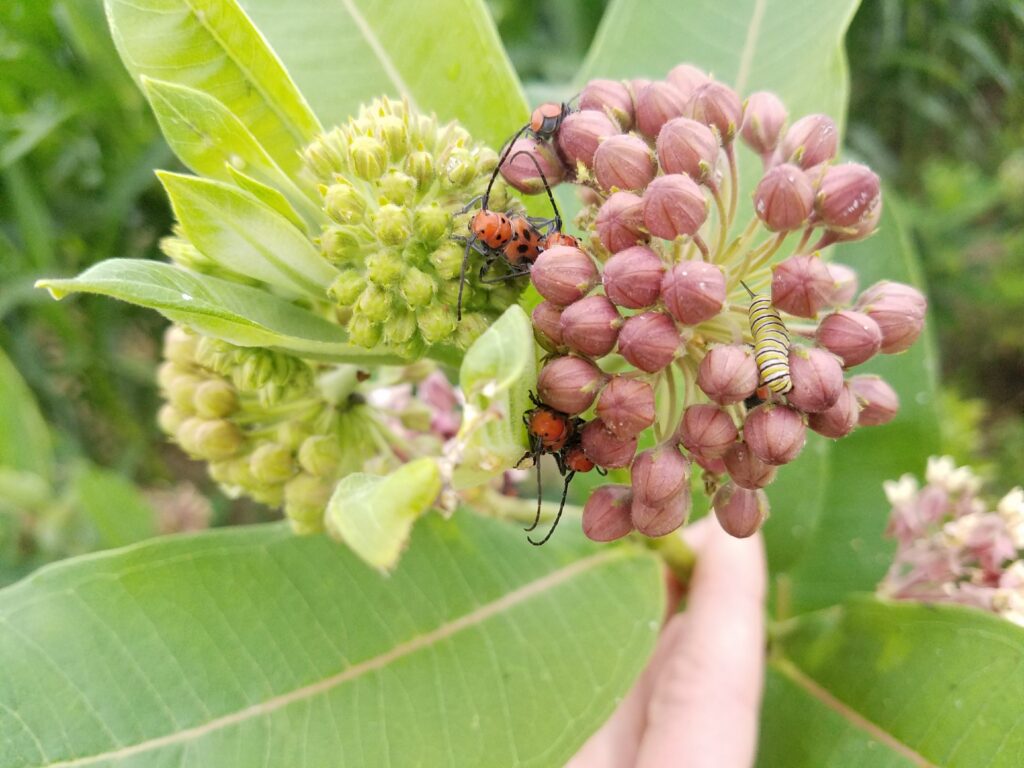Milkweed has received a lot of attention in recent years, mainly due to its status as a host plant for Monarch butterfly caterpillars.
Monarch caterpillars rely exclusively on milkweed as their source of food. For this reason, milkweed has become practically synonymous with Monarchs; one rarely discusses one without talking about the other. However, there is more to this plant than its role as a Monarch caterpillar host.
Milkweed is actually a generic term for a group of closely related species that belong to the genus Asclepias. Most people are familiar with common milkweed (Asclepias syriaca), but there are a total of 15 species of milkweed in Indiana alone! All share the characteristic of having milky sap, hence the term “milkweed.”
Milkweed sap contains toxins known as cardenolides that have cardiac effects. In addition to poisonous sap, most milkweed species have leaves that are either opposite (pairs of leaves that arise from the same point on a stem) or whorled (sets of 3 or more leaves radiating from a single point on the stem). They also have flowers with 5 petals and 5 sepals that curve down from the petals. The colors of the flowers are white (e.g. four-leaved milkweed), green (e.g. Mead’s milkweed), orange (e.g. butterflyweed), or purple (e.g. swamp milkweed).
Milkweed is a food source for hundreds of insects. Many are attracted to the nectar of the flowers while others, such as Monarch caterpillars, feed on the leaves and stems. All insects that regularly feed on milkweed stems and leaves are immune to the toxic cardenolides contained within milkweed sap. Many of these insects then store these poisons in their bodies and use it as a defense from predators. Often, these insects advertise their toxicity to potential predators with bright coloration, known as aposematism.
The frequently overlooked Milkweed Tussock Moth caterpillar (Euchaetes egle) is an insect that uses aposematism. These striking orange, black, and white caterpillars resemble colorful shag carpets in the later stages of development (known as instars). The hairs on these caterpillars can irritate the skin and also serve as a predator deterrent.
In addition to Milkweed Tussock Moths, other insects that feed on milkweed include the Large Milkweed Bug (Oncopeltus fasciatus), Small Milkweed Bug (Lygaeus kalmia), and the Red Milkweed Beetle (Tetraopes tetrophthalmus). The first two species are very similar and colored red with black blotches whereas the latter is red with black spots.
These non-Monarch insects tend to be indiscriminately killed by well-meaning people who believe they will harm Monarchs or compete with them for food. Large and Small Milkweed Beetles are known to consume milkweed seeds which can reduce the number of milkweed plants in an area over time. However, Milkweed Beetles do not consume seeds and their impact on milkweed numbers is insignificant. It is important to remember that all these insects are native and are fulfilling their role.
If you enjoy milkweed and would like to learn how to make your garden more attractive to wildlife such as the Milkweed Tussock Moth, Red-tail Land Conservancy’s Growing Home Habitat Certification can help. Visit the Growing Home website to download a guide and lists of native plants that attract beautiful and beneficial wildlife, beyond the Monarch caterpillar. Learn more at www.fortheland.org/growinghome.
Photo: Milkweed Beetles and a Monarch caterpillar sharing the flowers of Common Milkweed.
Taylor Lehman is the Stewardship Manager for Red-tail Land Conservancy. She is dedicated to restoring natural areas that support diverse plant and animal communities.




